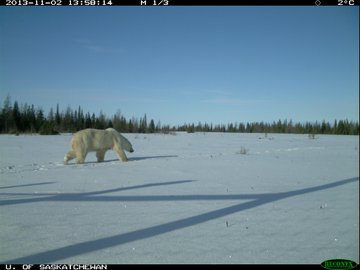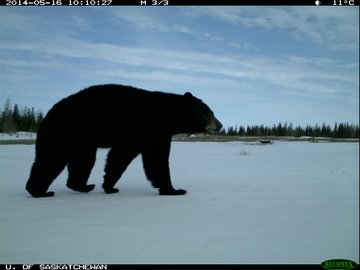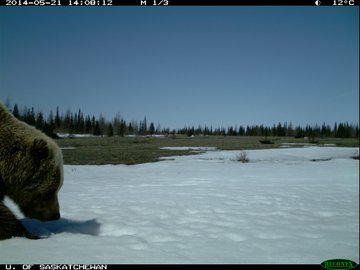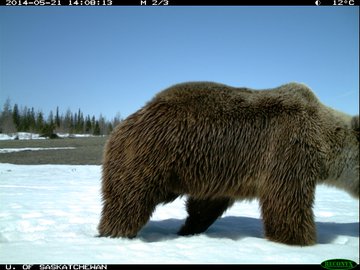Here's the spot where all three North American bears rub shaggy shoulders
Here's the spot where all three North American bears rub shaggy shoulders
BY Ethan Shaw JANUARY 26 2017
Since 2011, Douglas Clark, an associate professor in the University of Saskatchewan's School of Environment and Sustainability, and his students have been using trail cameras to assess those polar bears of the well-known Western Hudson Bay population that seasonally inhabit Wapusk, where Clark once worked as a warden.
FROM LEFT TO RIGHT-TOP ROW POLAR AND BLACK BEAR...............BOTTOM RIGHT IS THE GRIZ
Grizzly bears were once thought to be extinct in Manitoba but have been observed in Wapusk since the 1990s. Image: University of Saskatchewan
Ongoing research on polar bears in northeastern Manitoba's Wapusk National Park, along the western shores of Hudson Bay, has lately showed the area boasts a rare distinction: one of the few places where all three North American bear species share the very same turf.WAPUSK NATIONAL PARKMANITOBA, CANADA
Since 2011, Douglas Clark, an associate professor in the University of Saskatchewan's School of Environment and Sustainability, and his students have been using trail cameras to assess those polar bears of the well-known Western Hudson Bay population that seasonally inhabit Wapusk, where Clark once worked as a warden.
FROM LEFT TO RIGHT-TOP ROW POLAR AND BLACK BEAR...............BOTTOM RIGHT IS THE GRIZ
one @usask remote camera observes all 3 Cdn bear species in one spot w/i 7 months, Wapusk National Park @ParksCanada
In addition to valuable information about the great ice bears – like their activity patterns and their physical condition over time – the images collected have also revealed the presence of both black and grizzly bears in the same areas.Until a few decades ago, grizzly bears were considered extirpated from Manitoba, the southern prairies of which they formerly swaggered around. Beginning in the 1990s, however, sporadic observations began trickling in from the province's subarctic north; as a park warden at Wapusk, Clark himself logged the second confirmed sighting of a grizzly in northern Manitoba in 1998.
Clark told the CBC this month that local traditional knowledge suggests the occasional presence of grizzlies in the Wapusk region in the more distant past. The rising number of observations this century of the silver-tipped bears, though, seems to suggest a genuine increase in the area, likely an expansion into northern Manitoba by so-called barren-ground grizzlies from populations in Nunavut to the north.
These high-latitude grizzlies of northern Canada and Alaska are among the smallest and scrappiest brown bears in North America, roaming vast lean tundra territories and hunting ungulates – caribou and muskoxen – to a greater extent than many other grizzly populations. Barren-ground grizzlies have strayed deep into polar-bear territory in the past several decades: they've been documented as far north as Melville Island in the Canadian Arctic Archipelago, where some grizzlies appear to be stalking the sea ice rather like their big white cousins.
American black bears, meanwhile, reach the northern limits of their range where the boreal forest (taiga) of Canada and Alaska yields to Arctic tundra. Black bears are predominantly forest-dwellers, a habitat preference that may at least partly be a strategy to avoid grizzlies, which will kill black bears (even eat them) but, with their long, straight foreclaws, are poor tree-climbers.
Southwestern Wapusk encompasses the ecotone between taiga and tundra, and the park's southeast includes partly timbered coastal fens, both offering refuge for black bears. The park notes, however, that black bears have been seen "at camps far out on the tundra" as well – a local expression, perhaps, of a broader trend, as black bears have recently showed up well north along the tundra coast of Hudson Bay near the Nunavut community of Arviat as well as barren northernmost Quebec.
A few years back, Clark tweeted a series of snapshots showing all three bear species lumbering past the very same Wapusk trail camera within the space of seven months: a polar bear in November 2013, then a black and grizzly in May of the following year.
According to CBC News, Clark suspects barren-ground grizzlies may possibly be denning in the Wapusk area, given the same bear has triggered the same camera in successive years. A 2009 report on the increasing grizzly presence in Wapusk suggested the park's interior peatlands, which are home to one of the largest maternity denning zones for polar bears in the world, could offer similar "winter haven" for grizzlies.
That report suggested that if grizzlies did indeed overwinter in the Wapusk peatlands, they might potentially pose a threat in spring to freshly emerged polar-bear cubs. (In 1991, a barren-ground grizzly likely killed a two-year-old polar bear in the Canadian Arctic Archipelago.)
WAPUSK NATIONAL PARK
WAPUSK NATIONAL PARK
On their hardscrabble diet, barren-ground grizzlies usually max out around 227 to 272 kilograms (500 to 600 lbs.); polar bears (and the brown bears of coastal southern Alaska) may be twice that weight. Yet observations from whale-carcass scavenging bonanzas on the Alaskan North Slope suggest grizzlies, despite their size disadvantage, can dominate polar bears due to a generally meaner disposition.
And then of course there are the much-publicised grizzly/polar-bear hybrids that have been periodically showing up along the leading edge of the barren-ground grizzly’s northward expansion.
Just how polar bears and grizzlies are getting along in Wapusk National Park – and how both interact with the black bear – isn't clear, but Clark and his team's findings suggest this might well be the best place in North America to scrutinise the interrelations among these three husky cousins.
















1 comment:
North America is amazing place to see bears and I always like to bears and northern lights. Book now alaska bear viewing trips
Post a Comment